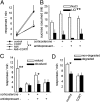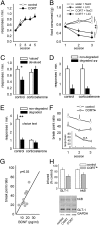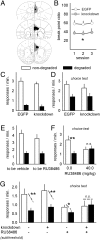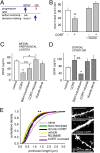Action control is mediated by prefrontal BDNF and glucocorticoid receptor binding
- PMID: 23185000
- PMCID: PMC3528547
- DOI: 10.1073/pnas.1208342109
Action control is mediated by prefrontal BDNF and glucocorticoid receptor binding
Abstract
Stressor exposure biases decision-making strategies from those based on the relationship between actions and their consequences to others restricted by stimulus-response associations. Chronic stressor exposure also desensitizes glucocorticoid receptors (GR) and diminishes motivation to acquire food reinforcement, although causal relationships are largely not established. We show that a history of chronic exposure to the GR ligand corticosterone or acute posttraining GR blockade with RU38486 makes rodents less able to perform actions based on their consequences. Thus, optimal GR binding is necessary for the consolidation of new response-outcome learning. In contrast, medial prefrontal (but not striatal) BDNF can account for stress-related amotivation, in that selective medial prefrontal cortical Bdnf knockdown decreases break-point ratios in a progressive-ratio task. Knockdown also increases vulnerability to RU38486. Despite the role of BDNF in dendritic spine reorganization, deep-layer spine remodeling does not obviously parallel progressive-ratio response patterns, but treatment with the Na(+)-channel inhibitor riluzole reverses corticosteroid-induced motivational deficits and restores prefrontal BDNF expression after corticosterone. We argue that when prefrontal neurotrophin systems are compromised, and GR-mediated hypothalamic-pituitary-adrenal axis feedback is desensitized (as in the case of chronic stress hormone exposure), amotivation and inflexible maladaptive response strategies that contribute to stress-related mood disorders result.
Conflict of interest statement
The authors declare no conflict of interest.
Figures





Similar articles
-
A history of corticosterone exposure regulates fear extinction and cortical NR2B, GluR2/3, and BDNF.Neuropsychopharmacology. 2009 Feb;34(3):707-16. doi: 10.1038/npp.2008.123. Epub 2008 Aug 20. Neuropsychopharmacology. 2009. PMID: 18719621 Free PMC article.
-
Persistent effects of prior chronic exposure to corticosterone on reward-related learning and motivation in rodents.Psychopharmacology (Berl). 2013 Feb;225(3):569-77. doi: 10.1007/s00213-012-2844-4. Epub 2012 Sep 15. Psychopharmacology (Berl). 2013. PMID: 22983097 Free PMC article.
-
Glucocorticoid-sensitive ventral hippocampal-orbitofrontal cortical connections support goal-directed action - Curt Richter Award Paper 2019.Psychoneuroendocrinology. 2019 Dec;110:104436. doi: 10.1016/j.psyneuen.2019.104436. Epub 2019 Sep 6. Psychoneuroendocrinology. 2019. PMID: 31526526 Free PMC article.
-
The Medial Orbitofrontal Cortex Regulates Sensitivity to Outcome Value.J Neurosci. 2016 Apr 20;36(16):4600-13. doi: 10.1523/JNEUROSCI.4253-15.2016. J Neurosci. 2016. PMID: 27098701 Free PMC article.
-
Prefrontal cortical trkB, glucocorticoids, and their interactions in stress and developmental contexts.Neurosci Biobehav Rev. 2018 Dec;95:535-558. doi: 10.1016/j.neubiorev.2018.10.015. Neurosci Biobehav Rev. 2018. PMID: 30477984 Free PMC article. Review.
Cited by
-
Differential expression of cytoskeletal regulatory factors in the adolescent prefrontal cortex: Implications for cortical development.J Neurosci Res. 2017 May;95(5):1123-1143. doi: 10.1002/jnr.23960. Epub 2016 Oct 13. J Neurosci Res. 2017. PMID: 27735056 Free PMC article. Review.
-
Adolescent rats are resistant to forming ethanol seeking habits.Dev Cogn Neurosci. 2015 Dec;16:183-190. doi: 10.1016/j.dcn.2014.12.002. Epub 2014 Dec 24. Dev Cogn Neurosci. 2015. PMID: 25575668 Free PMC article.
-
Morphological Responses of Excitatory Prelimbic and Orbitofrontal Cortical Neurons to Excess Corticosterone in Adolescence and Acute Stress in Adulthood.Front Neuroanat. 2020 Sep 8;14:45. doi: 10.3389/fnana.2020.00045. eCollection 2020. Front Neuroanat. 2020. PMID: 33013327 Free PMC article.
-
Drug-Induced Glucocorticoids and Memory for Substance Use.Trends Neurosci. 2018 Nov;41(11):853-868. doi: 10.1016/j.tins.2018.08.005. Epub 2018 Aug 28. Trends Neurosci. 2018. PMID: 30170822 Free PMC article. Review.
-
Chronically dysregulated corticosterone impairs dopaminergic transmission in the dorsomedial striatum by sex-divergent mechanisms.Neuropsychopharmacology. 2023 Aug;48(9):1328-1337. doi: 10.1038/s41386-023-01551-1. Epub 2023 Feb 21. Neuropsychopharmacology. 2023. PMID: 36810463 Free PMC article.
References
-
- Dias-Ferreira E, et al. Chronic stress causes frontostriatal reorganization and affects decision-making. Science. 2009;325(5940):621–625. - PubMed
-
- Duman RS, Heninger GR, Nestler EJ. A molecular and cellular theory of depression. Arch Gen Psychiatry. 1997;54(7):597–606. - PubMed
-
- De Kloet ER, Vreugdenhil E, Oitzl MS, Joëls M. Brain corticosteroid receptor balance in health and disease. Endocr Rev. 1998;19(3):269–301. - PubMed
Publication types
MeSH terms
Substances
Grants and funding
LinkOut - more resources
Full Text Sources
Molecular Biology Databases

